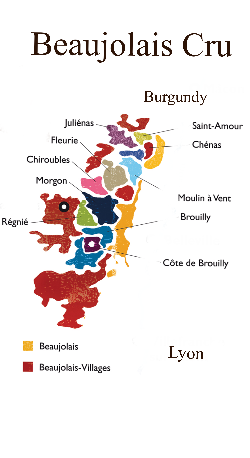
If I had said "a very good Beaujolais," you probably would have hit the delete button, right? But, stay with me on this one. When most people think of Beaujolais, they think of the bubble gum-like Beaujolais Nouveau, or an inexpensive, thin, basic Beaujolais. However, there are some very nice “Beaujolais Cru” wines to be had at a decent price – as our wine of the week will demonstrate. About the only thing the Cru have in common with the lesser Beaujolais wines is that they are made from the same grape – Gamay.
Beaujolais generally.
- Beaujolais is located just south of Burgundy. In fact, there is a slight overlap between the southern Burgundy Mâconnais region and the northern Beaujolais Cru of Saint Amour. Historically, Beaujolais was part of Burgundy, but the two wine regions are separate today.
- Beaujolais wines are almost exclusively red, and made almost exclusively from Gamay. Except for several of the Cru, Beaujolais wines generally are best consumed within a year or two of the vintage. They're typically light or medium bodied and very fruity.
- There are several different quality levels.
-
- Beaujolais Nouveau. A masterful marketing scheme, this light, fruity wine is released to great fanfare on the third Thursday of November. All that need to be said here is: friends don’t let friends drink Beaujolais Nouveau.
- Beaujolais. The entry level category, it can be produced anywhere in the region but typically comes from the south, where the soils are less favorable for Gamay. These wines are lighter and less concentrated than the higher quality wines, but can make a decent, inexpensive quaffer.
- Beaujolais-Villages. This is a step up in quality. These wines typically are more concentrated and interesting, and some pretty good values can be found. In some cases the village name is appended, which means that the wine was produced solely from grapes from that village.
- Beaujolais Cru, discussed below, are serious, more full-bodied wines.
There are ten Beaujolais Cru. As you can see from the graphic above, all ten Cru are located in northern Beaujolais, where the vineyards are found on granite hillsides that are ideally suited for Gamay. Typically, the bottle label will bear only the Cru appellation and producer name, but not “Beaujolais.”
- Four of the Cru are generally bold and full-bodied. Those are Moulin-à-Vent (considered the most prestigious of the Cru), Juliénas, Morgon and Chénas. These wines need several years in the bottle to mellow. With age, the best become more like a Burgundy - when that happens a wine is said to “pinoter.”
- The other six Cru are lighter bodied and often less age worthy. These are Saint Amour, Fleurie (considered the most "feminine" and "elegant" of the Cru), Chiroubles, Régnié, Côte de Brouilly and Brouilly.
Our Wine of the Week is a 2015 Stephane Aviron Morgon “Côte de Puy” (about $20 retail). This wine is produced on what may be the finest terroir in Beaujolais (the vineyard sits on an inactive volcano) from very old vines (at least 40 years old). It's aged twelve months in oak, and produced using classic Burgundy techniques. Consequently, it can easily be confused with a fine Burgundy. On the nose and palate, it has earthy and red berry notes, with a hint of spice. It's medium-bodied, with firm tannins and a medium finish.
- You'll want to decant this wine for an hour or so to allow the tannins to soften and the fruit to develop. If you don't, you'll miss out on much of what the wine has to offer.
- We served it with Kerry Gold "Dubliner" cheese to start, and a salmon dish, and it paired wonderfully. You could also pair this wine with charcuterie, Brie or Camembert cheese, roast chicken, and grilled pork or veal.
- Morgon wines typically can improve with bottle age for up to ten years.
All things considered, the Aviron Morgon is a great, relatively low-priced alternative to a village-level Burgundy.
Cheers!
